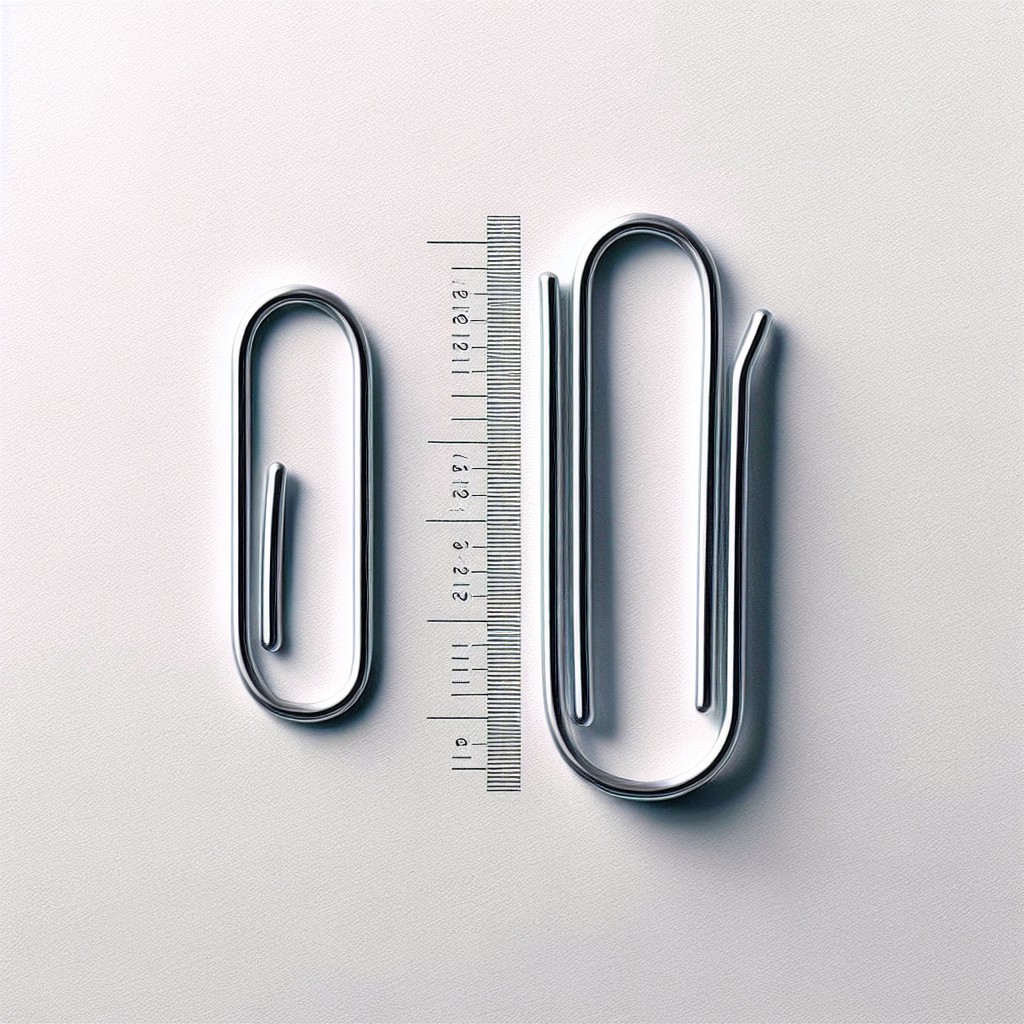Last updated on
Understanding the size of 2cm becomes incredibly easy when you compare it to everyday objects, because such familiar comparisons help in instant visualization.
Imagine holding a small object between your fingers and trying to gauge its size; this tactile trick is something we often do to understand dimensions in a tangible way. When it comes to 2 centimeters, a measurement that might seem abstract at first, placing it in the context of everyday items brings clarity.
This article does just that, serving as a visual guide to comprehending the scale of 2cm. We’ll explore familiar items, from the width of a penny to the size of a dime, to give you a concrete sense of this measurement.
With practical examples, you’ll soon be able to visualize 2 centimeters with ease, making your real-world estimations and comparisons surprisingly accurate.
Key takeaways:
- Penny diameter: slightly wider than 2cm
- Rubber band width: roughly 2cm
- Staple leg length: around 1cm, two side by side
- USB stick width: close to, but larger than 2cm
- Dime diameter: about 1.8cm
What's Inside
Visual Comparisons of 2 Centimeters

Grasping the size of 2 centimeters (cm) is simpler when visual examples are at hand. Think of the diameter of a penny; it’s just a smidge wider than 2cm. Envision the width of a standard rubber band, which is roughly the same length. If you have a staple handy, the length of one leg is often around 1cm, so two side by side would give you the size you’re looking at. Lastly, picture the width of a typical USB stick, which is close to, but a tad larger than, 2cm across. Using these everyday items provides a tangible sense of the dimension we’re talking about.
A Dime

When you hold a dime in your hand, you’re looking at a familiar object that can help you visualize 2 centimeters, as the diameter of a dime is just about 1.8cm.
This makes the dime a handy reference when you need a rough estimate of a 2cm length.
If you picture two stacks of dimes side by side, they would almost align perfectly with a 2cm measurement.
Keep in mind, if you need a precise measure, nothing beats a tool designed for the job, like a ruler, but for an on-the-go estimate, a dime can be quite useful.
A House Key
Most house keys have a length that spans approximately 2 to 3 centimeters across the teeth or bitting area, which is the part of the key that engages the locking mechanism within a lock.
For visual reference:
- Focus on the key’s teeth or ridged edge; this section often falls within the 2cm measurement.
- Compare this length to a standard metric ruler to get a sense of the key’s scale.
- Understanding this can help in identifying the key’s profile for lock fitting or in situations requiring precise measurements.
- Always keep in mind the variability in key sizes based on brand and lock type; our focus here is on the most common residential key dimensions.
Using a Ruler to Measure 2cm
Understanding how to use a ruler is fundamental for accurately measuring 2 centimeters. Here are some points to help you nail it every time:
- Align Correctly: Position the edge of the item or distance you wish to measure against the zero mark on the ruler, not the end of the ruler, to ensure accuracy.
- Read Metric Side: Ensure you’re looking at the centimeter (cm) scale, typically the top portion of the ruler, where the longer lines with numbers represent centimeters.
- Identify Marks: The smaller lines between centimeter marks represent millimeters (mm). Ten millimeters make up 1 centimeter.
- Locate 2cm Point: Count two large numbered lines from zero to find the 2cm mark.
- Check Alignment: Confirm the item or length you’re measuring stretches out to the second large marked line on the ruler.
- Precision: For a precise measurement, make sure the ruler is straight and your eye level is directly above the 2cm point to avoid parallax errors.
Using the ruler properly can help you reliably measure and visualize what 2 centimeters represents in practical settings.
Estimating Centimeters Using Objects
Recognize everyday items as approximate centimeter guides: a standard paperclip or a large button often runs close to the 2cm mark.
Consider the width of your pinky finger: for many adults, this falls within the 1-2cm range, offering a quick visual gauge.
Get creative with tech: the thickness of a standard smartphone is another tangible reference, with many models measuring around the 7mm to 9mm range—stack two smartphones, and you’re in the ballpark of 2cm.
Keep in mind the power of approximation: while these objects provide a handy reference, they’re not substitutes for precise measuring tools when accuracy is essential.
Converting Metric Units to Centimeters
Understanding the metric system is a key to making sense of the measurements in centimeters. Here’s a quick guide to help you visualize and convert within this system:
- Millimeters to Centimeters: Since there are 10 millimeters (mm) in 1 centimeter (cm), 2cm equals 20mm. To convert mm to cm, simply divide by 10.
- Meters to Centimeters: One meter (m) contains 100cm. To find out how many centimeters are in a particular measure of meters, multiply by 100. Therefore, 0.02 meters equals 2cm.
- Kilometers to Centimeters: A more extensive unit, one kilometer (km), equates to 100,000cm. Converting km to cm involves multiplying by 100,000. Thus, 2cm is a mere 0.00002km.
Armed with these simple conversion principles, you can easily switch between different metric units and understand just how significant or minute measurements are relative to each other.
Converting U.S. Standard Units to Centimeters
To bridge the gap between the metric system and the U.S. standard units, familiarize yourself with some basic conversions. For length, one inch equates to 2.54 centimeters. Therefore, 2 centimeters is just a tad shy of 0.79 inches.
A straightforward way to convert inches to centimeters is by multiplying the inch value by 2.54.
Here’s an illustrated example: If you’ve got a short length of ribbon that’s exactly 0.79 inches long, you’re holding roughly 2cm. This conversion is useful in various settings, from school projects to construction work, where precise measurement matters.
Keep in mind that in most tape measures used in the U.S., you’ll find small markings that denote inches and larger intervals for fractions of an inch. To visualize 2 centimeters, you’d look for a spot a touch below the 1-inch mark, between the ¾ and 1-inch mark, to be precise.
Furthermore, when dealing with smaller units like feet, remember that one foot contains 12 inches or approximately 30.48 centimeters. Hence, 2cm makes up a small fraction of a foot and is useful when you need to note down fine measurements beyond the scope of feet or inches.
FAQ
How long does 2 cm look?
Two centimeters approximately equates to 0.8 inches.
What’s something that’s 2cm?
A peanut is an example of an object that measures approximately 2 centimeters.
What is an example of a 2 cm length?
An example of a 2 cm length is the combined diameters of three hexagonal pencils.
How can one visualize the size of 2cm?
To visualize the size of 2cm, consider it approximately the length of a standard new pencil eraser.
Which common household items are approximately 2cm in length?
Common household items approximately 2cm in length include a paperclip, LEGO bricks, and small buttons on a remote control.
What common objects can you compare for a better sense of the size of 2cm?
A 2cm object is approximately the same length as a U.S. nickel’s diameter, or slightly smaller than an SD card.




